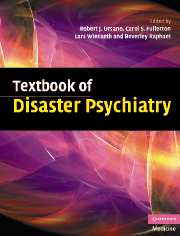Crossref Citations
This Book has been
cited by the following publications. This list is generated based on data provided by Crossref.
Ursano, Robert J.
Benedek, David M.
Hamaoka, Derrick A.
Fullerton, Carol S.
and
Kessler, Ronald C.
2007.
EDITORIAL COMMENTARY: Prevalence of and Sex Disparities in Posttraumatic Stress Disorder in an Internally Displaced Sri Lankan Population 6 Months After the 2004 Tsunami.
Disaster Medicine and Public Health Preparedness,
Vol. 1,
Issue. 1,
p.
41.
Heo, Ji-hoon
Kim, Min-Hyuk
Koh, Sang-Back
Noh, Samuel
Park, Joon-Ho
Ahn, Joung-Sook
Park, Ki-Chang
Shin, Jongho
and
Min, Seongho
2008.
A Prospective Study on Changes in Health Status Following Flood Disaster.
Psychiatry Investigation,
Vol. 5,
Issue. 3,
p.
186.
Raphael, Beverley
2008.
The challenges of purpose in the face of chaos: commentary paper by Professor Beverley Raphael.
International Journal of Methods in Psychiatric Research,
Vol. 17,
Issue. S2,
p.
S42.
2008.
The Encyclopedia of Psychological Trauma.
p.
643.
Ng, Chee
Ma, Hong
Raphael, Beverley
Yu, Xin
Fraser, Julia
and
Tang, Denghua
2009.
China–Australia Training on Psychosocial Crisis Intervention: Response to the Earthquake Disaster in Sichuan.
Australasian Psychiatry,
Vol. 17,
Issue. 1,
p.
51.
Ursano, Robert J.
Fullerton, Carol S.
and
Benedek, David M.
2009.
Mental Health and Disasters.
p.
131.
Galea, Sandro
and
Maxwell, Andrea R.
2009.
Mental Health and Disasters.
p.
579.
Parker, Robert M
Ng, Chee
Coghlan, Andrew
Fraser, Julia
and
Raphael, Beverley
2009.
The China–Australia training on psychological crisis intervention for medical aid leaders and volunteers after the Sichuan earthquake.
Medical Journal of Australia,
Vol. 190,
Issue. 9,
p.
508.
Neria, Yuval
Galea, Sandro
and
Norris, Fran H.
2009.
Mental Health and Disasters.
p.
1.
Raphael, Beverley
and
Maguire, Paul
2009.
Mental Health and Disasters.
p.
7.
Macdonald, Elspeth
2009.
Mental health needs post‐disaster: Supporting recovery of children and families.
Australian Occupational Therapy Journal,
Vol. 56,
Issue. 2,
p.
79.
Turnip, Sherly S
Klungsøyr, Ole
and
Hauff, Edvard
2010.
The mental health of populations directly and indirectly exposed to violent conflict in Indonesia.
Conflict and Health,
Vol. 4,
Issue. 1,
Kirmayer, Laurence J.
Kienzler, Hanna
Hamid Afana, Abdel
and
Pedersen, Duncan
2010.
Principles of Social Psychiatry.
p.
155.
Zeng, Emily
2011.
The Wiley‐Blackwell Handbook of Group Psychotherapy.
p.
623.
Clettenberg, Stacey
Gentry, Judy
Held, Matthew
and
Mock, Lou Ann
2011.
Traumatic loss and natural disaster: A case study of a school-based response to Hurricanes Katrina and Rita.
School Psychology International,
Vol. 32,
Issue. 5,
p.
553.
Kapfhammer, H.-P.
2011.
Psychiatrie, Psychosomatik, Psychotherapie.
p.
1808.
Howe, Edmund G.
2011.
How Can Careproviders Most Help Patients during a Disaster?.
The Journal of Clinical Ethics,
Vol. 22,
Issue. 1,
p.
3.
Ajdukovic, Dean
Math, Suresh Bada
Naveen Kumar, Channaveerachari
Christine Nirmala, Maria
and
Okasha, Tarek A.
2011.
Post‐Traumatic Stress Disorder.
p.
263.
Raphael, B
and
Ma, H
2011.
Mass catastrophe and disaster psychiatry.
Molecular Psychiatry,
Vol. 16,
Issue. 3,
p.
247.
Goldenberg, Matthew N.
Benedek, David
and
Ursano, Robert J.
2012.
Handbook of Community Psychiatry.
p.
435.





